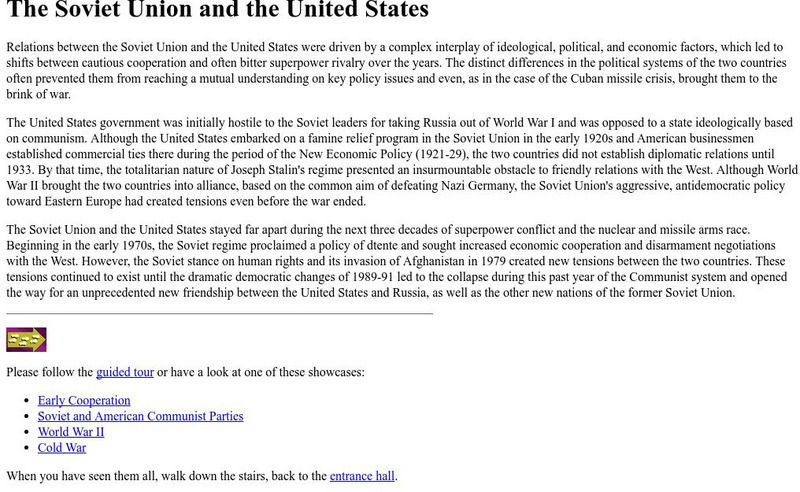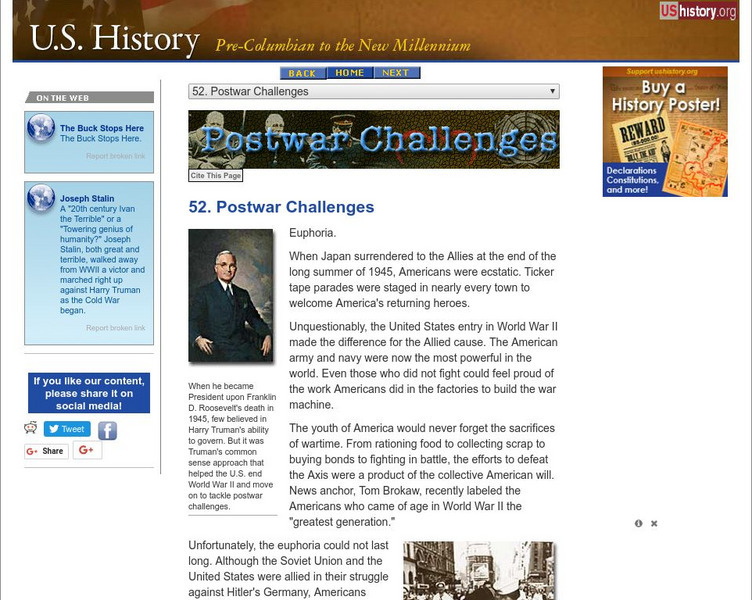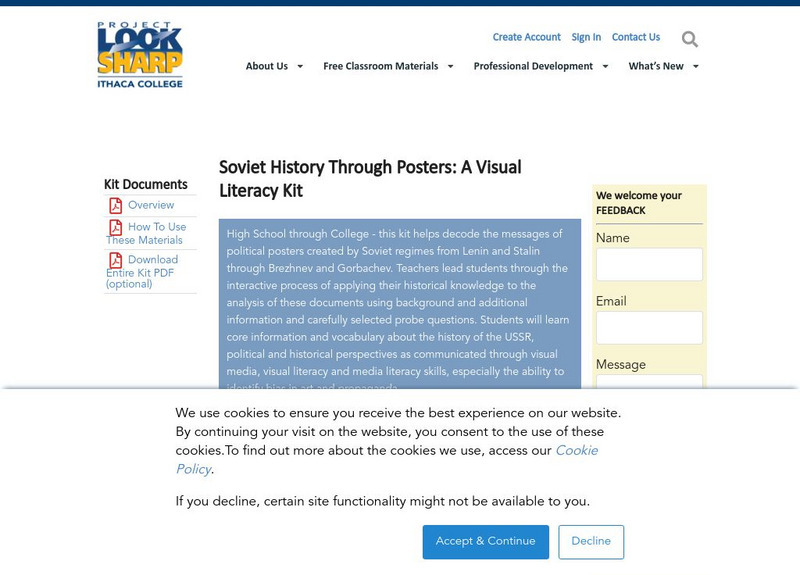George Mason University
Gmu: History and Collections: Women in the u.s. Military 1950s
Read about why the military had such a hard time recruiting women to serve in the 1950s. Find out about the unequal treatment afforded female members of the military.
US Army Center
U.s. Army Center of Military History: The u.s. Army in Vietnam
This site gives an in-depth look at the U.S. Army action during the Vietnam War. To find more information about Diem's overthrow, look under the section labeled 635.
PBS
Pbs Learning Media: Writing in u.s. History: Shaping the Postwar World
Consider how U.S. foreign policy changed in the aftermath of WWII, and analyze the philosophical, geopolitical, and economic factors that influenced these changes. In this interactive lesson from WGBH, students develop a written argument...
Woodrow Wilson International Center for Scholars
Woodrow Wilson Center: Digital Archive: Intelligence Operations in the Cold War
A collection of primary source documents that discuss intelligence issues during the Cold War. The documents come from archives in many different Soviet bloc countries. They are mainly decision memorandums, descriptions, agreements, and...
Texas Education Agency
Texas Gateway: The Cold War and the American Home Front
Students will identify ways in which Cold War tensions were intensified.
Mount Holyoke College
David T. Fautua: The "Long Pull" Army of Korean War
Provides a lengthy account of United States Cold War policy, NSC-68, and the United States policy towards the Korean War.
University of Groningen
American History: Outlines: The Cold War at Home
Overview of the profound effect the Cold War had on domestic life and government policy in the U.S.
Mount Holyoke College
Mount Holyoke College: Early Cold War Era u.s. Foreign Policy
In his article entitled "Economic Interests, Party, and Ideology in Early Cold War Era U.S. Foreign Policy", Benjamin O. Fordham discusses the United States' foreign policy during the Cold War, focusing on the country's ideology, party...
PBS
Pbs: American Experience: The Berlin Airlift
A comprehensive overview of the Berlin Airlift provides links to maps, timelines, and other resources. The entire film is not available at this time, however, a short clip can be viewed. Coverage of the Chocolate Pilot and the support by...
ibiblio
Ibiblio: The Soviet Union and the United States
This site from ibiblio.org gives information about the historical relationship between the Soviet Union and the United States. After reading the summary on this page, click on the links at the bottom of the page to read about early...
University of Groningen
American History: Outlines: u.s. Urges Alliance for Progress
In the field of foreign affairs, President Kennedy faced a series of challenging situations in Cuba, in Southeast Asia, and in Berlin. In 1961, he initiiated a program called the Alliance for Progress aimed to establish economic...
Georgia Department of Education
Ga Virtual Learning: Ap Us History: The Cold War
AP U.S. History unit on post-World War II and the Cold War. Comprehensive multi-media lessons, activities and assessment.
US Department of State
U.s. Department of State: Decades of Change: 1960 1980
Summary of the rise of cultural and ethnic pluralism that took place in America between 1960 -1980 causing major social change. Included were such movements as civil rights, women, Latino, Native-American, counterculture,...
City University of New York
American Social History Proj.: Decoding u.s. Foreign Policy: Iran Contra Affair
Students explore the Iran-Contra Affair using a timeline and related documents, and practice critical thinking about US foreign policy during the late Cold War years, and about the actions of officials of Ronald Reagan's government. They...
US National Archives
Nara: Teaching With Documents: The United States Enters the Korean Conflict
This is a lesson plan outline which correlates the relationship between NSC-68 and U.S. policy in Korea. A National Archives and Records Administration site (NARA) with additional links to more teaching resources.
Alabama Learning Exchange
Alex: News Flash: The End of the Cold War
This instructional activity is an inquiry into events that occurred during the Cold War era. It is a technology-based project on one event that occurred during the Cold War(1945-1991). The Cold War describes the tense and hostile...
Independence Hall Association
U.s. History: Postwar Challenges
A brief survey of the beginning of the Cold War and the challenges that faced the United States in confronting communist totalitarianism.
Library of Congress
Loc: Cold War Cuban Missile Crisis
This site details the placing of intermediate-range nuclear missiles in Cuba by the Soviet Union. The article discusses why Khrushchev did this, and what the U.S. did about this. Also provided is the text to Krushchev's letter to JFK...
US Army Center
U.s. Army Center of Military History: The Centennial: Omar Nelson Bradley
This lengthy biography of General Omar Bradley was written on the centennial of his birth. It traces his life as a military man through World War I, World War II, and Chairman of the Joint Chiefs of Staff. Included is a map that shows...
US National Archives
Docs Teach: President Reagan and the Cold War: Vision and Diplomacy
See how Ronald Reagan's rhetoric evolved from his speech calling the Soviet Union an "evil empire" to his signing of the Intermediate-Range Nuclear Forces Treaty by examining photographs and documents.
Other
Ithaca College: Project Look Sharp: Soviet History Through Posters
[Free Registration/Login Required] Multi-unit curriculum kit on the history of the Soviet Union told in five episodes using Soviet posters as source material. Coverage includes the birth of the Soviet Union, Stalin, the Great Patriotic...
Smithsonian Institution
National Air and Space Museum: Apollo to the Moon
This resource offers an in-depth exploration of the U.S. space program and the role President John F. Kennedy took in setting the agenda for manned space flight to the moon.
A&E Television
History.com: The Mariel Boatlift: How Cold War Politics Drove Thousands of Cubans to Florida in 1980
After Fidel Castro loosened emigration policies, some 125,000 Cubans landed on U.S. shores over a span of five months. The Mariel Boatlift of 1980 was a mass emigration of Cubans to the United States. The exodus was driven by a stagnant...
A&E Television
History.com: The Mariel Boatlift: How Cold War Politics Drove Thousands of Cubans to Florida in 1980
After Fidel Castro loosened emigration policies, some 125,000 Cubans landed on U.S. shores over a span of five months. The Mariel Boatlift of 1980 was a mass emigration of Cubans to the United States. The exodus was driven by a stagnant...
















